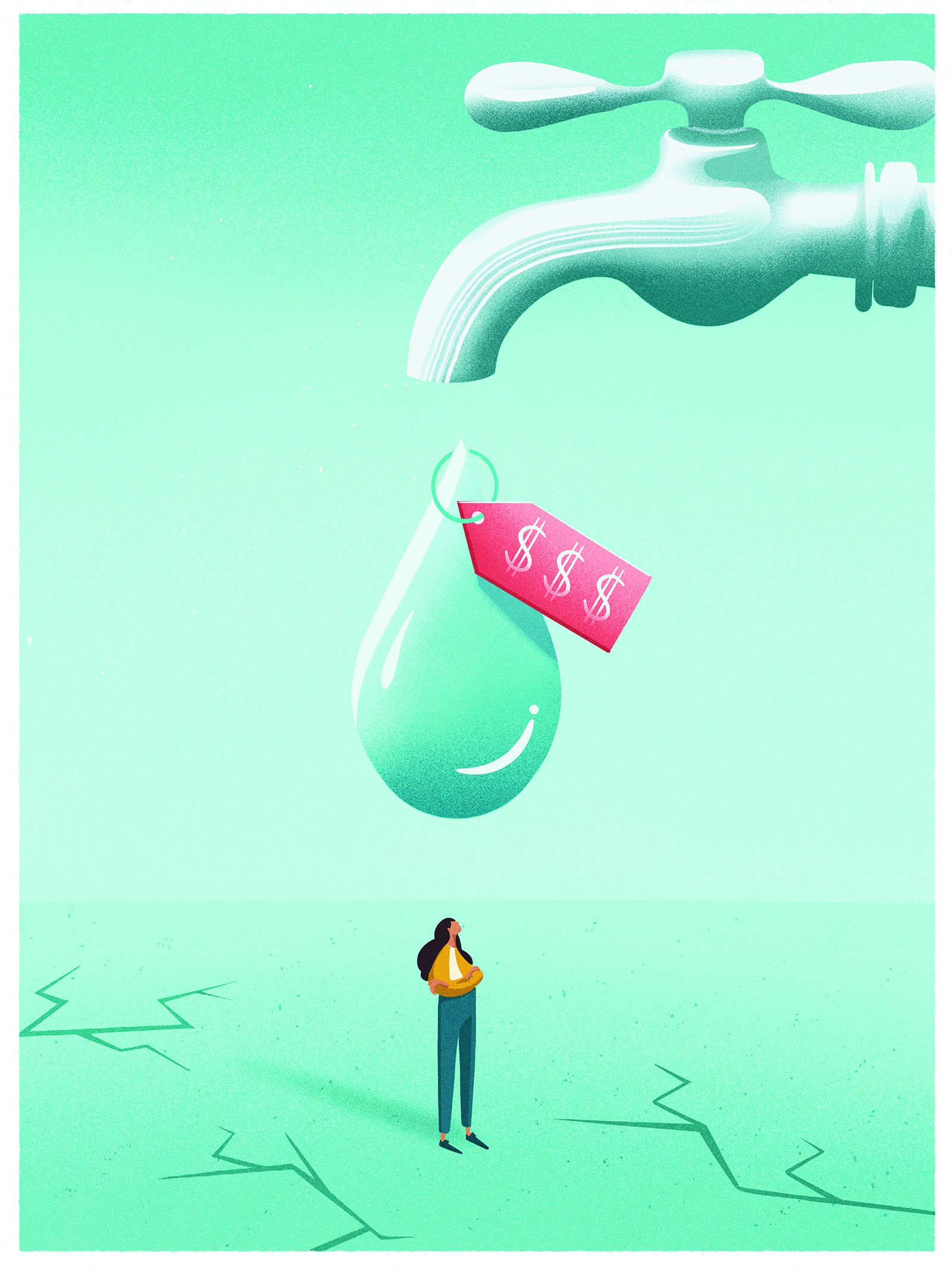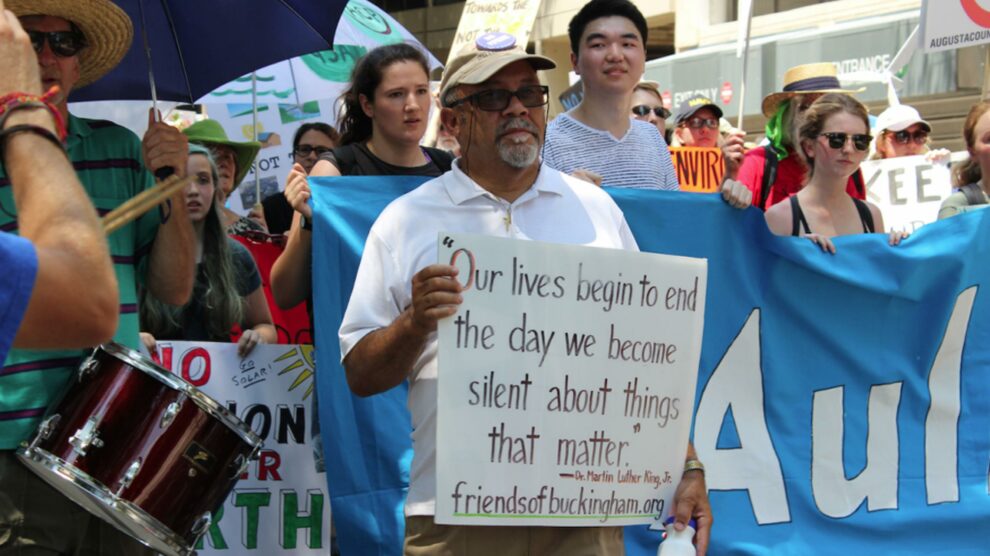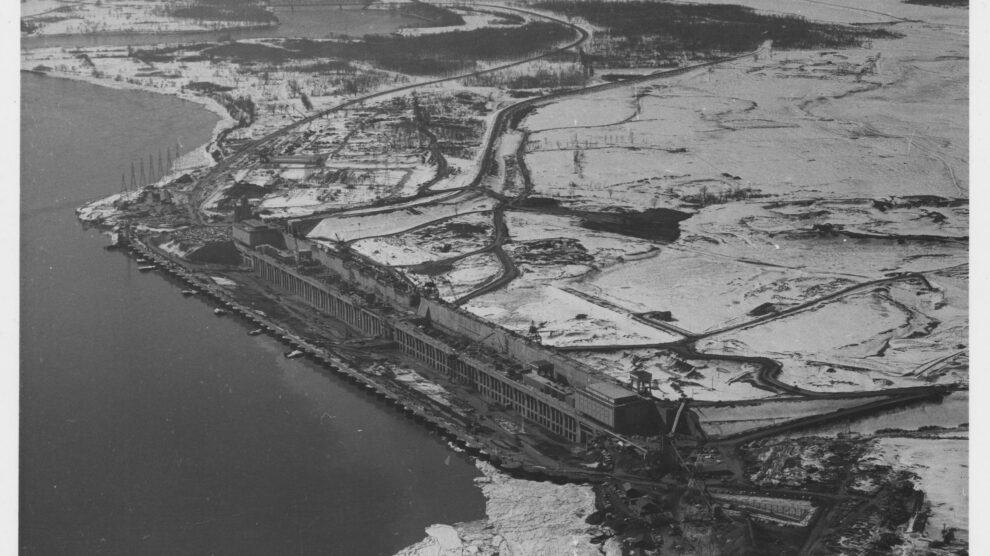Water: Private Property or Human Right?
By Marta Lizcano Barrio (trans: A. Elizabeth Brown)
Volume 25, no. 2, Bleeding Earth
This article is originally published in Spanish. Lee este artículo aquí.

Water is essential to life. In some parts of the world, at least at the moment, we take it for granted: just turn on a tap to get clean, safe drinking water. However, in many other areas it is a scarce commodity and, due in part to climate change, water shortages have become more acute. Climate change creates water crises at both ends of the spectrum, floods and droughts, and both can have disastrous effects on the supply of safe, clean water. Scarcity of safe drinking water due to extreme events and to gradual desertification, both driven by climate change, will become increasingly frequent if we do not do something to stop the drift.1
For example, in sub-Saharan Africa, women and girls travel on average more than 30 minutes to collect drinking water.2 In rural Asia, it is 21 minutes. Since they are in charge of getting safe drinking water for their families, these women and girls bear some of the harshest consequences of water scarcity.
The general scarcity of safe water in many places has been made far worse by a worldwide wave of privatization over the last few decades. The overexploitation of aquifers, the sale of bottled water, industrial and agricultural pollution, large hydroelectric projects, and the privatization of distribution networks are some of the forms taken by the capitalist plundering of water.
The synergistic effects of privatization and climate-change-driven water scarcity are not a set of isolated events, but rather a global dynamic. So any effective response to the problem must be global and coordinated.
Overexploited Aquifers
Aquifers, one of the planet’s main sources of fresh water, are geological formations capable of storing and releasing water that surfaces in the form of springs. Aquifer water can satisfy most domestic and industrial needs: safe drinking water and irrigation are two common uses.3
But if water is consumed faster than it is replenished, the aquifer can lose its regenerative capacity, threatening a community’s main source of water. Overexploitation becomes rife when private companies have unlimited rights to drain an aquifer, causing continued, inordinate pressure on that aquifer and resulting in water cuts and shortages. When private enterprise drains aquifers solely for private gain, wells that were previously used for household consumption or irrigation no longer have enough. Drilling to greater and greater depths, at enormous expense, becomes necessary to feed wells that once furnished safe drinking water. In addition, rivers and riparian areas once fed adequately by the aquifer lose all kinds of living creatures—plants, animals, fungi—to migration or death.4
Throughout the world, the needs of business are taking precedence over those of people and nature as a whole. In today’s manifestation of colonialism, companies based in Europe and the United States seek (and usually find) unrestricted access to natural resources in areas where governmental weakness or corruption makes the water grab easier.5 All of this takes place under the aegis of multinational corporations (“multinationals”).
As one of thousands of examples, the Coca-Cola Corporation has owned and operated a bottling plant called La Constancia/SabMiller in Nejapa, El Salvador since 1999. La Constancia/SabMiller draws vast amounts of water from the local aquifer to bottle soft drinks, water, beer and other beverages. The demand on the aquifer per liter of soft drink is a whopping two liters of water.6
Despite the many commitments made by the company, among which is to return to nature the same amount of water it consumes, experts and neighbors say that in the case of Nejapa the promises are not being kept.7 In typical greenwashing fashion, the company has organized sports championships and planted trees. At the same time, the company manages to avoid its legal and ethical obligations to the community for as long as it can: for example, it was able to delay till 2013 a required environmental impact study and the installation of meters to monitor the pressure exerted on the aquifer.8
Paradoxically, bottled beverages are flying off store shelves while the people of Nejapa frequently suffer water cuts that can last several days. In 2015, La Constancia/SabMiller had plans to expand its operations, but according to experts the resulting increase in consumption would have drained the aquifer completely by 2042. Thanks to popular pressure, however, the expansion was halted.9 The urgency of putting the needs of the population before corporate economic interests has become clearer: a new water law, which the Salvadoran government finally approved last December 2021, decrees that water and sanitation are human rights.10 However, the law also provides for use and exploitation authorizations for terms of up to fifteen years, so the real impact of the legislation on the lives of the Salvadoran population will be revealed only over the long term.
History repeats itself in different parts of the world. In the case of Chiapas, Mexico, fifty-year water use and exploitation agreements signed by the Coca-Cola Corporation require the company to pay only 2,600 pesos per concession, a laughably tiny amount compared to the 32.5 billion pesos that the company earned in 2007. This pittance is woefully insufficient to compensate the people who live in Chiapas for the loss of their public water.11 Meanwhile, the typical cost to Mexican families of water bottled and sold by Coca-Cola, as of 2010, was 1,800 pesos.12
Things are not much different in India, where Coca-Cola first established a manufacturing presence in 1993. It now operates fifty-seven factories spread throughout the country. The company’s impact is significant and predictable. In Uttar Pradesh, for example, the local Coca-Cola factory has completely drained the aquifer that used to feed public wells. Now women have to walk further to get each day’s drinking and cooking water, and water for irrigation and farm animals is scarce too. However, some of the company’s plans for new projects have been paralyzed, thanks to popular opposition inspired by a noteworthy community victory against the Plachimada plant in Kerala in 2005.13
The profit motive of the multinationals takes precedence over the basic needs of the population—often rural and settled in drought-prone areas—who are heavily dependent on freshwater sources for their economic activities. Even if these companies were being socially and ecologically responsible, as they claim, one wonders whether such overexploitation practices are legitimate when they override a human right such as access to water.
The Ripple Effects of the Bottled Water Business
Bottling water for sale is intimately related to the problem of overexploited aquifers. As in the case of Nejapa, large aquifers are frequently drained for bottling water. This is, in the first place, a problem for the people who inhabit these lands, whose water resources are taken from them for sale back to them, turning the right to water into a class privilege available only with cash. The vast number of plastic bottles used to hold the water creates a serious ecological problem. Transportation of the bottled water to points of sale drives up CO2 emissions, and the bottles are difficult if not impossible to recycle. Finally, bottled water itself, which is supposedly safe to drink, contains microplastics. Although microplastic particles are also found in tap water, bottled water samples were found to contain up to twice as much of some types of microplastics as tap water does.14
The bottled water business has been the subject of great controversy, since in many cases the water sold is nothing more than water obtained from rivers, or directly from the tap, treated for commercialization. Such is the case in the US state of Michigan, where the main difference between the two types of water is its price. Nestlé pays $3.50 per 1,000 gallons and sells it to the people whose resources are exploited for hundreds of times that amount.15 A similar controversy took place in 2004 in London: at that time, Coca-Cola was selling half-liter bottles of water at €1.41, when it had paid only €0.004 per half-liter to purchase the water.16
The sale of bottled water should never be necessary: in its place should be adequate sanitation and distribution measures. Bottled water pollutes the environment and is not especially safe to drink. It benefits only the companies that sell it, impoverishing its rightful owners, the people who live near the aquifers that are drained.
However, the growth of the bottled water trade has accelerated over the last few decades. Bottled water began to become popular in the 1970s and 1980s as a result of campaigns to discredit tap water and to point out the virtues of bottled water.17 The irony is that the safety of tap water is typically more regulated, making it a more reliable source of good drinking water. In some places, such as Spain, bottled water is replacing traditional street drinking water fountains.18 As bottled water replaces publicly available water for drinking, cooking, and other needs, it is putting in danger the availability of free or very inexpensive water as a fundamental human right.
Privatization of Distribution Networks
Urban water distribution networks are also falling victim to the privatization wave. Under pretexts such as “efficiency,” private companies are replacing public agencies in the management of drinking water distribution, often with dire consequences. Private companies are not necessarily better managers, nor do public services need to be profitable. Public agencies are charged with the equitable distribution of drinking water, independent of residents’ purchasing power, which is not the case, for example, with bottled water.
The consequences of the appropriation of water by private companies include layoffs, water cut-offs, worsening service, and increasing water pollution. Entities such as Barcelona’s Agbar/SGAB, whose parent company is the French multinational Suez, pride themselves on being “a group of companies with more than 150 years of experience,” with a presence in some 1,600 cities around the world.19 Their business depends on the total privatization of drinking water or, in the best of cases, participation in public-private joint ventures.
Agbar’s activities in Saltillo, Mexico are paradigmatic. Agbar set up shop in Saltillo in 2000. With the advent of privatization, the cost of water went up tenfold, and eight percent of the population has had its water cut off.20 In addition, townspeople denounce lack of pressure, leaks, and the abandonment of treatment plants, which has led to contaminated water being drained directly into the local canal. Predictably, the aquifer in the area is being overexploited, a problem that will only increase with the construction of the model city of Derramadero.
Why would Agbar choose Saltillo as a place to do business? Some journalists point out that multinationals usually go to places with high levels of corruption and a weak judicial system. Mexico is one of those places: only two percent of alleged crimes are ever investigated. They also reveal the risk involved to journalists, government officials, and others who investigate these cases.
In the face of the damage wrought by privatization, numerous people’s collectives have risen up in defense of public water. But they demand not simply a return to public management of water, but to transcend it and go for re-municipalization: a model that includes the collective reappropriation of water resources and greater social control over them. However, re-municipalization is possible only when current concessions come to an end and before new ones are awarded. This often means a delay of periods of up to ninety-nine years, although some collectives have already succeeded in their goals. In Terrassa, Spain, for example, the company MINA (part of Agbar) had to cede control to the municipality in 2018 at the end of a seventy-five-year concession.
The Insidious Impacts of Hydroelectric Power
Although hydropower is often considered renewable and “green,” the creation of dams as water containment barriers has caused untold damage. First of all, on the environmental level, it means that areas whose flora and fauna rely on periodic flooding are no longer flooded. This leads to flight or die-off of species. And damming often involves the clearing of vegetation for construction. Finally, the elimination of natural flooding, construction with gas-driven equipment, and clearing of vegetation increase methane emissions and limit the uptake of carbon dioxide, contributing directly to anthropogenic climate change.21
In theory, many of these macro-projects are legally required to consult with Indigenous and tribal peoples about any planned resource exploitation programs on their lands.22 However, the consultation step is frequently omitted without consequence to the businesses. If these consultations were carried out as required, the response could be forceful enough to stop the planned project altogether, which is what happened in 1996 with the Corpus Christi project in Paraguay and Argentina.23 In most cases, though, these projects go ahead unimpeded. Hydroelectric dams have displaced between forty and eighty million people worldwide, in many cases without compensation or the option of resettlement.24
Along with forced exile comes the separation of families and the destruction of cultural heritage. Just as one example, the Munduruku, Apiaka and Kayabi peoples suffered greatly when a hydroelectric power project was authorized for the Sete Quedas waterfall, a site of great spiritual importance located between Paraguay and Brazil. At times the impact of these projects results in nothing less than ethnocide25: families lose not only their homes but their main source of water and subsistence.26
Faced with this situation, the question arises: electricity, for whom, and at what price?
As the same patterns of plunder occur and recur all over the world, a global resistance movement is growing in response. These are not merely local, isolated tragedies: they affect the whole world.27 Similarly, the problem is not a specific dam, but the prevailing privatization model as a whole. Among the associations involved are the Movement of People Affected by Dams in Brazil (MAB) and the Interamerican Association for Environmental Defense (AIDA). These groups use diverse tactics, including demonstrations, sit-ins, marches, caravans, escraches (gatherings at the homes of those responsible to call them out), use of social networks, takeovers of facilities, and legal actions.28
Unfortunately, police and military often repress these mobilizations viciously, sometimes leading to assassinations. One such martyr for water as a human right was Noé Vázquez Ortiz, an activist known for his opposition to the El Naranjal hydroelectric project in Veracruz, Mexico.29
Simply Put: A Struggle for Life
The struggle for water is the struggle for life. Excessive use or misuse of water resources causes myriad alterations in ecosystems, ranging from the disappearance of species to the acceleration of climate change. As an essential resource, water should be protected as a human right in every corner of the world.
However, large multinationals always put their profits before the most basic human rights. We cannot expect them to change their predatory practices. One thing is becoming increasingly clear: there is no future without nature. If we want to guarantee the quality of our lives, lives that are not limited to mere survival, we must continue to organize ourselves globally and be the wave that says: enough is enough!
Notes
- “Climate Change 2022: Impacts, Adaptation and Vulnerability”, Intergovernmental Panel on Climate Change, accessed August 1, 2022.
- “La búsqueda de agua es a menudo una pérdida de tiempo colosal para las mujeres y las niñas, dice UNICEF”, UNICEF, August 29, 2016.
- “Hydrogeology”, Hispagua Spanish Water Information System, September 8, 2022.
- Alejandra Borunda, “La sobreexplotación de los acuíferos está acabando con nuestros ríos”, National Geographic, March 5, 2020.
- “Las falsas promesas de la energía hidroeléctrica”, Interamerican Association for the Defense of the Environment, accessed August 1, 2022.
- Maribel Hernández, “El uso de un acuífero para hacer Coca-Cola amenaza el agua de 30.000 personas en El Salvador”, El Diario, June 15, 2015; “Las falsas promesas…”, see footnote 5.
- “Coca-Cola devolvió a la naturaleza el equivalente al 129% del agua contenida en las bebidas vendidas en España en 2019”, Coca-Cola España, March 20, 2020.
- “La ampliación de una embotelladora de Coca-Cola amenaza con dejar sin agua a 30.000 personas en El Salvador”, Alianza por la Solidaridad, May 6,2015; Hernández, “El uso de un acuífero…”, see footnote 6.
- TIERRRA, “Inversión extranjera en una planta embotelladora en El Salvador: El caso de Nejapa” (Alianza por la Solidaridad: 2015).
- “El Salvador aprueba ley que garantiza el agua y el saneamiento como derechos humanos”, El Salvador Ministry of the Environment, accessed August 1, 2022.
- Redacción El Salto, “Coca-Cola seca los pozos de Chiapas a cambio de 150 dólares anuales”, September 15, 2017; Angélica Enciso L., “México, primer lugar en consumo de agua embotellada; la demanda crece 40%” La Jornada, May 18, 2010.
- Enciso L., “México, primer lugar en consumo de agua embotellada”.
- Víctor M. Olazábal, “El mal trago de Coca-Cola en India”, El Mundo, January 25, 2016,; “Las mujeres de Kerala contra Coca-Cola,” Coca-Cola Spain (blog), November 10, 2016.
- “Microplásticos también en el agua embotellada”, Cadena SER, March 15, 2018.
- “Underground Profits: Nestle’s Clutch on Michigan Water”, WoodTV, May 11, 2017; “How Nestle Makes Billions Bottling Free Water”, AJ+, May 24, 2018, YouTube video, 12:06.
- “Coca Cola vende en Reino Unido agua del grifo como agua mineral”, Cadena SER, February 3, 2004.
- Christine Verschuur et al., Género, movimientos populares urbanos y medioambiente (Spain: Instituto of Political Studies for Latin America, 2010).
- Fernando Ruso, “Sevilla, mucho calor y poca agua”, El Mundo, July 19, 2010; Luis de la Cruz, “Ciudad sedienta: ‘mal caminando’ por un Madrid con pocas fuentes públicas”, El Diario, June 14, 2021.
- “Descubre quiénes somos”, Grupo Agbar, accessed August 9, 2022.
- “Aigua Tèrbola: el negoci d’Agbar a Mèxic”, Ingeniería sin Fronteras, 24 mayo 2022, YouTube video, 37:49.
- Luna Gámez, “El ‘ecopostureo’ de las hidroeléctricas en América Latina”, Público, August 11, 2019.
- Convenio Núm. 169 de la OIT sobre Pueblos Indígenas y Tribales: Declaración de las Naciones Unidas sobre los Derechos de los Pueblos Indígenas (Perú: Organización Internacional del Trabajo, 2014).
- “Argentina: Masivo rechazo de votantes a construcción de represa”, Inter Press Service, April 15, 1996.
- Represas y desarrollo: Un nuevo marco para la toma de decisiones (México: Comisión Mundial de Represas, 2000).
- Members of the Pariri Indigenous Association and Ipereğ Ayũ Movement, “A Government of Death is Plundering Our Ancient Munduruku Lands. Help Us Stop It”, The Guardian, April 25, 2017; “Las falsas promesas…”, see footnote 5.
- Pablo Albarenga y Caio Mota, “La batalla contra el tiempo de los indígenas para salvar su territorio”, El País, June 2, 2019.
- Patrick McCully, Ríos silenciados: Ecología y política de las grandes represas (Argentina: Proteger, 2004).
- Anahí Gómez et al., “Resistencias sociales en contra de los megaproyectos hídricos en América Latina”, Revista Europea de Estudios Latinoamericanos y del Caribe, n.º 97 (2014): 75–96.
- Autor De Old Kaos, “México: Asesinan al activista Noé Vázquez, miembro del Colectivo Defensa Verde Naturaleza para Siempre y del MAPDER”, Kaos en la Red, August 3, 2013.





